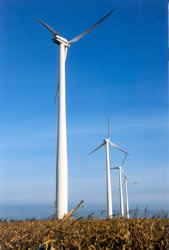Harnessing the Wind

Renewable energy sources have the added benefits of lower air emissions and play a significant role in reducing our nation’s dependence on foreign oil supplies. Renewable energy facilities—wind, solar and hydroelectric—are derived from replenishable resources that are available in many regions of the country.
In the Midwest, three technologies comprise the majority of utility-scale renewable energy sources: hydroelectric, wind and biomass. Wind power is now the fastest-growing energy source in the world, which has helped reduce the cost of production. In the past five years, wind power production has increased nearly 32 percent annually and currently provides nearly one percent of the total energy production globally. A single utility-scale wind turbine can prevent the emission of 1,500 tons of carbon dioxide into the atmosphere per year. The Midwest has some of the highest wind power potential on earth, and Iowa, Minnesota and Wisconsin are all in the top 20 for wind power potential.
 Today’s most common wind turbines have a capacity of 1.5MW to 2.0MW and stand approximately 400 feet from the ground to the top of the blade. The amount of electricity generated by a 2MW wind turbine provides enough power to service 500 to 600 homes annually.
Today’s most common wind turbines have a capacity of 1.5MW to 2.0MW and stand approximately 400 feet from the ground to the top of the blade. The amount of electricity generated by a 2MW wind turbine provides enough power to service 500 to 600 homes annually.
In 2006 President Bush committed to working toward a renewable energy initiative that would result in 20 percent of the nation’s energy coming from wind power by the year 2030. At the end of 2006, the U.S. had a total of 11,603MW of wind power operating in the field. That is the equivalent of 7,735 1.5MW wind turbines. This 11,603MW represents only 0.7 percent of the nation’s power. In order to reach the 20 percent level, the U.S. will need to increase the output to 320,000MW, equal to 213,333 1.5MW wind turbines.
Can this goal be met by the year 2030? Wind farm developers and energy companies say it can. It will need to be a nationwide effort with everyone working together to achieve the goal, from the federal government to the local landowner. Keep your eyes open as you travel the roads around central Illinois in the next few years and you will start to see more wind turbines being constructed in rural areas. You will also see large oversized trucks hauling the components of wind turbines from U.S. manufacturing plants to the wind farm sites.
The wind is a free and renewable resource. For more information on wind power visit www.awea.org. IBI

